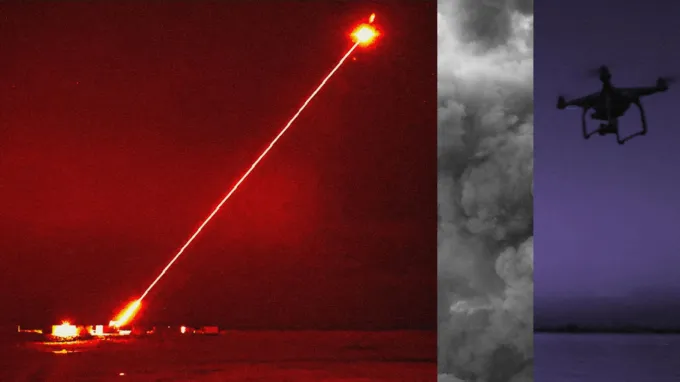 |
| Credit:BigThink |
Drones are effective weapons. They are small, cheap, and hard to shoot down. Or a defender can shoot down one drone can down if it sees the drone and aims a weapon at it.
When somebody defends targets against drones, they must not get any drone travel through the defense line. The Ukrainian war has shown that simple, so-called dummy drones can cause damage if they are used as large swarms.
Above:" The Huntress II Turbojet hybrid drone promises insane speeds and all-weather operation" WaveAerospace (New Atlas, Huntress hybrid drone packs a 300+ mph turbojet core)
The new tool in drone marketing is Huntress, a turbojet-powered quadcopter drone that can travel 30 kilometers. And the speed of that drone is 486 km/h. This kind of quadcopter can be the new type of loitering ammunition. The quadcopter can wait airborne and observe the right moment. Then it can attack against its targets which can be any military targets in the area.
Thermobaric explosives make those systems more deadly than ever before. And they can destroy things like electric transformer substations. These kinds of drones are hard targets for defenders because they are so fast. Those drones can also cause vital damage to warships and submarines. If they can make holes in the submarine's hull or detonate radar antennas they can cause bad damage.
Drones are also planned used as defensive tools. In some scenarios the drone swarms travel between incoming aircraft and targets. In those cases, the idea is that the jet engine pulls drones in their air inlets and the aircraft will impact them.
The mirrors over the battlefield can aim laser rays around corners and hindrances.
Drones can used as a defense system also against hypersonic missiles. The impact of drones in hypersonic speed is devastating. In some scenarios, hypersonic missiles are equipped with high-power radio or microwave systems that get energy from RAT (Rapid air turbine) systems. Those systems should suppress the air defense before the missile impacts. If those attackers use microwaves or some other EMP weapons they can sweep those drones out of their tracks.
The lasers and microwaves are the tools that should drop those drones. There is a possibility that the 360-degree microwave field is around vital targets. Those microwaves can destroy drones before they reach the target.
In that case, microwave transmitters are on every side of the building. And when the system activates them when the drones are coming. The microwave can affect the entire drone swarm. And in the same time, microwave weapons can destroy multiple drones.
But laser weapons are also effective systems. The British defense ministry tested their new high-power Dragonfire-laser systems. The reason, why laser systems are not "very popular" is they "cannot shoot over the hills and houses". Many people think. That lasers are limited only to the anti-aircraft and anti-drone roles.
The game is changing. There is a prediction that some "UFO observations are mirrors whose purpose is to aim laser rays at the targets. In those cases, small drones that carry accurately aimed mirrors can aim laser rays around corners and other hindrances. These kinds of systems are the ultimate tools for next-generation military applications.
https://bigthink.com/the-future/uks-dragonfire-laser-weapon-downs-its-first-drones/
https://interestingengineering.com/innovation/lockheed-martin-laser-us-navy
https://newatlas.com/drones/huntress-turbojet-drone/
https://learningmachines9.wordpress.com/2024/02/06/drones-require-a-new-type-of-defense/




No comments:
Post a Comment
Note: Only a member of this blog may post a comment.